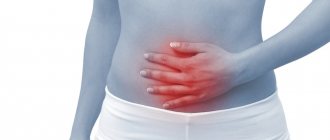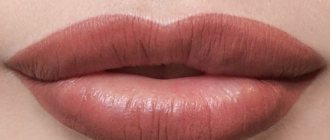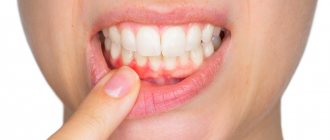These diseases are related to drug allergies, they spread to the oral cavity and can be combined with other lesions of the body. The most common cause is antibiotics (penicillin, tetracycline, streptomycin), sulfonamide drugs, analgesics, novocaine, iodine, bromides, etc.
The rate of development and severity of the allergic reaction depends on the method of administration of the drug. Often in pediatric dental practice, applications of painkillers and other medications are used. They most often cause sensitization. Frequent use and high dosage of the drug are also of great importance for the development of allergies.
The danger of drug allergies is that it combines all types of allergic reactions. This happens for several reasons. Firstly, as a result of the individual reactivity of the child’s body, as well as the presence of general somatic pathology. In addition, the nature of the drug allergen and the method of its administration are important.
What is allergic stomatitis?
Allergic stomatitis is called inflammation of the mucous membrane, provoked by hypersensitivity to certain irritants. A distinctive feature of the disease is a long incubation period. That is, from the moment an allergic reaction occurs until the first signs of stomatitis appear, up to four weeks can pass. In general, read about what stomatitis is in a separate article.
People of any gender and age are susceptible to the disease, but people with allergies, workers in hazardous industries and residents of areas with poor ecology are at risk.
Causes of allergic pharyngitis:
- strong odors (perfumes and chemical sprays, cigarette smoke and exhaust fumes);
- flowering period;
- book and house dust;
- pet hair;
- Food;
- medicines.
The development of the disease is often influenced by heredity, weak immunity, and chronic foci of infection. Allergic pharyngitis can also be triggered by hypothermia, smoking, etc. People who work in the production of chemicals are often at risk.
Symptoms of allergic stomatitis
Symptoms of allergic stomatitis in adults and children appear even at the initial stage of the pathology; the disease from the first days negatively affects the condition of the patient’s entire body.
Common signs of allergic stomatitis in the mouth include:
- itching and burning of the mucous membrane;
- pain when chewing;
- dry mouth;
- viscous saliva, similar in consistency to foam;
- swelling of the tongue, gums, swelling of the cheeks;
- fever and headache are possible.
Stages of the disease
- catarrhal allergic stomatitis - the initial form, characterized by dryness and burning in the mouth, without ulcers and plaque;
- bullous allergic stomatitis is the next stage, in which clusters of bubbles with cloudy liquid form on the surface of the mucosa;
- ulcerative necrotizing stomatitis is the most serious form, accompanied by severe pain, redness and swelling of the mucous membrane, and numerous ulcers with a gray coating.
Catarrhal and catarrhal-hemorrhagic stomatitis, cheilitis, glossitis
This is the mildest form of drug allergy. It is manifested by itching, burning, impaired taste sensitivity, dryness and pain when eating.
Clinical symptoms: hyperemia, swelling of the mucous membrane, as indicated by tooth marks on the lateral surfaces of the tongue and cheeks. Differential diagnosis is carried out with similar changes in the oral mucosa in cases of hypovitaminosis C, B, gastrointestinal diseases, infectious and fungal infections.
For this disease, both local treatment is used in the form of rinsing with antiseptic agents and taking painkillers, as well as general treatment: withdrawal of allergen medication, antihistamines (Diphenhydramine, Diprazin, Suprastin, Tavegil), calcium supplements. It is recommended to drink plenty of fluids and eat foods that do not irritate the mucous membranes.
Causes of development of allergic stomatitis
The main cause of pathology is the entry of an allergen into the body. Allergies can occur due to taking antibiotics, insect bites, accumulation of dust, food or contact with materials. Depending on the cause, there are several types of allergic stomatitis.
Contact allergic stomatitis
Occurs due to the effect of drugs and materials on the mucous membrane, for example, orthodontic apparatus, prosthesis or cement for its installation. The formations are usually located only at the site of contact of the mucous membrane with the irritant. A distinctive sign is swelling of the cervical lymph nodes.
Toxic-allergic stomatitis
Appears when pathogenic organisms multiply in the oral cavity, causing toxic poisoning. It is characterized by swelling of the mucous membrane, milky or brownish coating on the tongue.
Drug-induced allergic stomatitis
Develops after taking medications orally or when applied topically. Accompanied by nausea, headache, difficulty breathing, fever and numerous rashes. With drug-induced stomatitis, it is necessary to first relieve the symptoms of intoxication and only then treat the external manifestations of the pathology.
Ulcerative necrotic stomatitis, cheilitis, glossitis
This disease usually develops against the background of general severe allergic reactions affecting the skin, mucous membranes and internal organs. It develops acutely and is characterized by salivation, a pronounced bad breath with a sweetish taste. The mucous membranes show severe hyperemia and swelling with yellowish-gray foci of necrosis. Necrosis of the interdental papillae is observed, the mucous membrane is covered with a dirty gray fibrinous plaque, after removal of which an ulcerative, bleeding surface is exposed. The disease occurs against a background of general weakness; children experience headache, loss of appetite, pain in the mouth, which worsens when eating and talking, and sometimes increased body temperature. The submandibular lymph nodes are enlarged and painful.
When examining blood, an increase in the level of leukocytes - eosinophils and ESR is noted.
Treatment is based on the abolition of the drug that caused the allergy, the prescription of antihistamines, and in severe cases, corticosteroids, Hemodez, Poliglyukin, etc. are prescribed. Local treatment includes antiseptic treatment, removal of necrotic masses through the use of proteolytic enzymes, painkillers, keratoplasty.
Diagnostics
First of all, a visual examination is carried out: the dentist assesses the condition of the mucous membrane, looks for the presence of dentures, fillings and other materials that could become allergens. Then the doctor finds out the time of the first signs of the disease, the patient’s general well-being and possible factors of the disease: heredity, allergies, medication, diet, trips to other countries, contact with animals and insects. If allergic stomatitis is confirmed, tests are performed to clarify the allergen:
- study of the composition of saliva;
- sample from dentures or dental materials;
- immunogram;
- blood and urine tests.
Allergic pharyngitis. Diagnostics
An otolaryngologist can diagnose pharyngitis through a visual examination, but the type and nature of the allergen is determined by an allergist. Therefore, you need advice from two specialists at once.
Diagnosis of this disease includes the following studies:
- collection of anamnesis of the disease;
- pharyngoscopy, which allows you to examine the back of the throat for swelling and mucus formation;
- skin tests (detect the presence of patient hypersensitivity to the agent);
- laboratory tests for various allergens.
1 Pharyngoscopy - examination of the pharynx by an otolaryngologist at MedicCity
2 Pharyngoscopy - examination of the pharynx by an otolaryngologist at MedicCity
3 Laboratory diagnosis of allergic pharyngitis
Treatment of allergic stomatitis
Treatment involves eliminating the allergen, restoring the immune system and healing the mucosal tissue. The doctor prescribes antiallergic drugs, analgesics for severe pain, drugs to strengthen the immune system and ointments (Kamistad, Cholisal) to treat ulcers. It is important to avoid contact with the allergen: stop taking certain medications, remove certain foods from your diet, temporarily remove dentures, change oral care medications. The duration of treatment, as a rule, does not exceed 14 days, but in severe cases of the disease it can be extended by the attending physician.
To alleviate the patient’s condition, you can use traditional methods of treatment, but only after consulting a dentist:
- rinsing with cabbage juice, chamomile decoctions, aloe tinctures;
- treatment of affected areas with sea buckthorn oil;
- applying grated potatoes to the ulcers.
The principle of treatment of allergic stomatitis in adult and small patients is no different; the difference lies in the drugs. Depending on the age of the child, the doctor chooses more gentle medications or prescribes only medications for external treatment. Read more about the treatment of various types of stomatitis here.
1.General information
If you see a person’s face rapidly swelling, especially in the area of the eyelids and lips, the first thing that should come to mind is Quincke’s edema.
Acutely developing angioedema (neurovascular) edema is named after the German physician Heinrich Quincke, who gave the first detailed clinical description in 1882 (casuistic references to similar conditions have been found before). It is interesting that the term “Quincke’s edema” is used mainly in German- and Russian-speaking medicine, while in international English terminology they usually talk about “angioedema”.
Angioedema is one of the specific types of hypersensitivity reaction and can occur in any of us, regardless of age and gender. However, the predominance of young women (20-30 years old) among those with diagnosed episodes of Quincke's edema is sometimes reported. On the other hand, there is a form of angioedema (or rather, three subtypes) with a hereditary predisposition, first described by W. Osler six years after the publication of G. Quincke; In the presence of a family history, men are more often affected.
According to statistics, in the United States alone, angioedema causes emergency room calls about one hundred thousand times each year, and it consistently leads in the total number of allergic reactions and conditions that lead to hospitalization.
Sign up for a consultation
A must read! Help with treatment and hospitalization!
Prevention
If a patient once experiences allergic stomatitis, there is a high probability of it developing again. To prevent pathology, you need to pay attention to the following points.
- Immunity.
To strengthen the immune system and general health, it is recommended to take a course of comprehensive vitamin intake. - Nutrition.
It is better to exclude allergenic foods and hot spices from food and create a balanced menu. - Medicines.
When taking strong medications, especially antibiotics, it is necessary to include antihistamines, that is, antiallergic agents, in the list of medications. - Oral care.
If a toothpaste, brush or mouthwash causes discomfort, irritation or itching, you need to change the products yourself or choose the right ones together with your dentist.
The risk of developing allergic stomatitis and other diseases is minimal if you visit the dentist every six months for the prevention and timely treatment of pathologies in the early stages!
2. Reasons
Angioedema type 1 is usually associated with an acute allergic reaction localized in the upper part of the body and occurring in response to contact with a provoking substance. It can develop both independently and against the background of a provoked allergic status - for example, with urticaria, hay fever, etc. In general, Quincke's edema is most often compared with urticaria, although in the second case the reaction from the skin is not so deep and pronounced.
Another, non-allergic form of angioedema is caused by inherited dysfunction of the immune system, as a result of which a violent and inadequate immune reaction can occur suddenly, spontaneously, in response to almost any more or less intense irritant (for example, cold or hot air, chemical fumes, etc. .).
Visit our Allergology page
Quincke's edema: outpatient care
Sudden local edema, called angioedema (angioedema, giant urticaria), is encountered in the practice of a doctor of any specialty. They were first described in 1882.
The origin of this swelling may be different. They often appear as a result of contact with an allergen, that is, as a result of an allergic reaction (a reaction that occurs through immunological mechanisms). But Quincke's edema can also be of non-allergic origin (pseudo-allergic reactions). In this case, the edema reflects some other somatic pathology, most often various diseases of the gastrointestinal tract and hepatobiliary system. But in addition to gastroenterological pathology, the tendency to local edema is influenced by dysfunction of the endocrine system (or disorders of neuro-endocrine regulation), chronic foci of infection, tumor (Quincke's edema as a paraneoplastic reaction), systemic and some other diseases, and parasitic invasion. There are also edemas that appear under the influence of chemical (including medications) and physical (temperature, pressure, vibration) factors. Quite often, angioedema develops under the influence of several factors. There is hereditary vibration angioedema. Its mechanism is not clear; An increase in histamine levels was found after exposure to a vibration stimulus. The type of inheritance is autosomal dominant.
The general pathogenetic mechanism of any angioedema is a violation of the permeability of the microvasculature with the subsequent development of local edema.
The localization of edema can be different: face, mucous membrane of the oral cavity and gastrointestinal tract, larynx, external genitalia, parenchymal organs and meninges.
In most cases, edema is accompanied by urticaria (and angioedema itself can be considered as a deeper manifestation of urticaria), but they can also be an independent disease.
Another disease has a similar clinical picture - hereditary angioedema (HAE), which occurs as a result of congenital pathology - deficiency or functional inferiority of the inhibitor of the first component of complement.
Treatment for angioedema is carried out in 2 stages: the first is relief of the acute condition, the second is treatment of the cause of the disease. Treatment includes elimination of identified causative factors, symptomatic therapy, basic therapy and prevention of exacerbations (prevention of relapses of edema).
Localization of edema in the face, neck, oral cavity, and larynx can lead to asphyxia. Therefore, in such cases, treatment measures should be carried out quickly and efficiently. Difficulty breathing caused by swelling of the airways is a direct indication for hospitalization of the patient. The development of laryngeal edema may require emergency intubation or tracheostomy.
In addition, indications for inpatient treatment include intestinal edema, hypovolemia, failure of outpatient treatment, or the development of any life-threatening complications of angioedema. If there is no threat to the patient’s life, then treatment can be carried out on an outpatient basis.
The most commonly used drugs in the treatment of angioedema are histamine H1 receptor antagonists: fexofenadine in a dose of 60 to 240 mg 1-2 times a day; desloratadine - 5 mg/day; loratadine - 10 mg/day; cetirizine - 10–20 mg/day; ebastine - 10 mg/day; acrivastine - 8 mg 3 times a day; clemastine - 1 mg 2 times a day orally, 2 mg 2 times a day parenterally; chloropyramine - 25–50 mg/day orally, 20–40 mg parenterally; diphenhydramine - 30–50 mg 1–3 times a day orally, 20–50 mg 1–2 times a day parenterally; hydroxyzine - 25–50 mg every 6 hours; chlorpheniramine - 4 mg every 4-6 hours.
In more severe cases of angioedema, as well as when treatment with antihistamines is ineffective, a short course of parenteral treatment with glucocorticosteroids is administered: prednisolone - 40-60 mg/day, dexamethasone - 8-20 mg/day.
Further treatment of recurrent angioedema (second stage of treatment) will depend on the form of the disease.
Angioedema, occurring through the mechanisms of true allergy, requires unconditional elimination (exclusion) or limitation of contact with identified allergens in case of household, epidermal, pollen, food, occupational, drug, insect, fungal allergies. Otherwise, the treatment will be ineffective.
In the event of the appearance of angioedema resulting from exposure to physical factors, it is necessary to limit their effect on the patient: use photoprotective creams for angioedema due to insolation, avoid wearing heavy objects, tight shoes, use belts for edema resulting from pressure, avoid eating ice cream and other chilled drinks and foods for cold swelling, etc.
If the swelling is of non-allergic origin, then treatment is carried out after an in-depth clinical examination. It includes therapy for identified somatic pathologies (including rehabilitation of chronic foci of infection, such as tonsillitis, treatment of parasitic infestations, correction of intestinal dysbiosis, treatment of thyroiditis, diseases of the gastrointestinal tract and hepatobiliary system and other diseases that contribute to the development of pseudo-allergy). Such patients are prescribed a nonspecific hypoallergenic diet, which involves limiting the consumption of foods rich in histamine, tyramine, and histamine liberators (Table 1, 2, 3).
Symptomatic drug treatment of chronic, recurrent angioedema is also carried out with antihistamines. With a weak response to H1 receptor antagonists, the following are added to therapy: histamine H2 receptor antagonists (ranitidine - 150 mg 2 times a day, cimetidine - 300 mg 4 times a day, famotidine - 20 mg 2 times a day); leukotriene receptor antagonists (montelukast - 10 mg/day); calcium channel blockers (nifedipine - 20–60 mg/day).
For angioedema associated with systemic connective tissue diseases, drugs used in rheumatology (hydroxychloroquine, dapsone, colchicine, sulfasalazine) may be effective.
Treatment of hereditary angioedema is fundamentally different from the treatment of angioedema. Unrecognized HAE and, accordingly, inadequate therapy in many cases result in death. Diagnostic differences between HAE and allergic edema are presented in Table 4.
In the acute period, HAE is relieved by the administration of fresh or fresh frozen native plasma (replacement of C1 inhibitor deficiency), intravenous administration of tranexamic or aminocaproic acid. Danazol 800 mg/day (or stanozolol 12 mg/day) can also be administered. For swelling in the face and neck, furosemide (Lasix) and dexamethasone are additionally administered intravenously.
All patients with angioedema must have an “allergy patient passport” or a medical bracelet with information about the disease.
For questions regarding literature, please contact the editor.
S. V. Tsarev , Candidate of Medical Sciences, State Research Center Institute of Immunology, FU Medbioextrem, Ministry of Health of Russia, Moscow
Table 1. Products that can provoke angioedema
| Foods containing histamine-releasing substances | Foods rich in biogenic amines |
| Chocolate, strawberries, citrus fruits, tomatoes, crustaceans and oysters, coriander, pork, fish, alcohol, nuts, peanuts | Chocolate, sauerkraut, ham, stale cheese, fermented cheese, red wine, beer, fish, sausage; there is a lot of histamine in overripe and fermented foods |
Nutritional supplements:
|
Table 2. Foods High in Histamine
| Products | Histamine content (µg/g) |
| Fermented cheeses | Before 1330 |
| Fermented wines | 20 |
| Fermented foods: | |
| sauerkraut | 160 |
| cured ham and beef sausages | 225 |
| pork liver | 25 |
| Canned foods: | |
| tuna | 10-350 |
| anchovy fillet | 20 |
| herring fillet | 33 |
| herring caviar | 350 |
| Spinach | 37,5 |
| Tomatoes | 22 |
Table 3. Foods High in Tyramine
| Products | Tyramine content (µg/g) |
| Cheeses: | |
| Roquefort | More than 3000 |
| Camembert | 20-86 |
| brie | 180 |
| griar | 516 |
| Cheddar | 1466 |
| fused | 50 |
| Brewer's yeast | 1500 |
| Pickled herring | 3030 |
| Avocado | 23 |
Table 4. Differential diagnosis of hereditary angioedema and allergic edema
| Clinical and laboratory signs | Hereditary angioedema | Allergic edema |
| Presence of atopic diseases | Very rarely | Often |
| Relationship to allergen exposure | No | Eat |
| Trauma Connection | Clear | No |
| Blood eosinophilia | No | Often |
| Local hyperemia and itching | No | Eat |
| Hives | No | Eat |
| Effect of antihistamines and corticosteroids | No | Eat |
| Cyclicality | Often | No |
| Total IgE level | Norm | Often elevated |
| Complement system defect | There is always | No |
What to do
If a patient has a swollen tongue, treatment primarily depends on what causes the swelling. First of all, the cause should be determined; only an experienced doctor can do this. If the cause is known and it is not life-threatening (for example, biting the tongue or being burned by too hot food), then you can try to relieve the unpleasant symptoms yourself. But if the cause of tongue swelling is an allergic reaction, self-medication is life-threatening.
There are many ways to relieve swelling using traditional methods. However, all of them are suitable only for cases where the cause of swelling is microtrauma of the tongue.
You can rinse your mouth with decoctions of medicinal herbs - chamomile, sage, calendula, eucalyptus. You can use baths and rinses made from chlorhexidine, various herbal balms and rinses. If the patient's tongue is swollen after tooth extraction, rinsing with herbal infusions will help. It should be remembered that in this case you should absolutely not rinse your mouth with hot infusion, it will only increase inflammation.
3. Symptoms and diagnosis
Regardless of the etiopathogenetic mechanism (allergic or congenital), Quincke's edema manifests itself primarily as severe swelling of the subcutaneous tissue and mucous membranes, mainly in the face and neck; The triad in the title of the article is especially noticeable. Swelling of the genitals, hands, feet, and internal organs is less common. Angioedema differs from similar conditions (the same urticaria) by the absence of itching and a more pronounced vascular reaction. However, many patients note a burning sensation or other noticeable discomfort.
Swelling of the larynx and structures of the respiratory system is very dangerous: sudden suffocation, stridor (wheezing) breathing and acute oxygen starvation occur, which can be fatal.
The clinical picture forms very quickly - within a few minutes or, maximum, 1.5-2 hours.
For a doctor, angioedema does not present diagnostic difficulties, as well as for a non-specialist who has at least once seen this condition with his own eyes. After visiting a doctor, allergy tests are prescribed, and the anamnesis is carefully studied in order to clarify the hereditary or allergic etiology.
About our clinic Chistye Prudy metro station Medintercom page!










